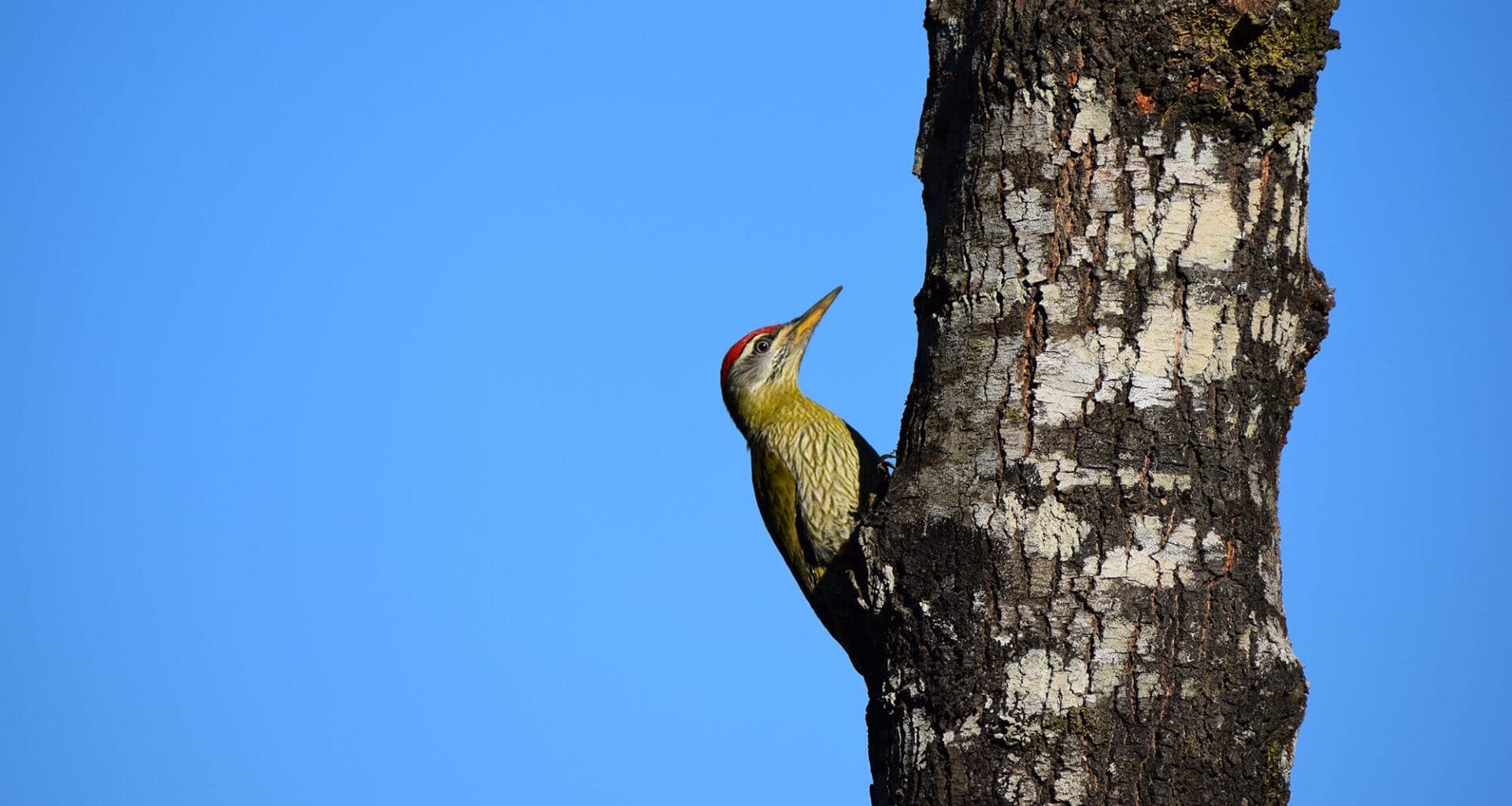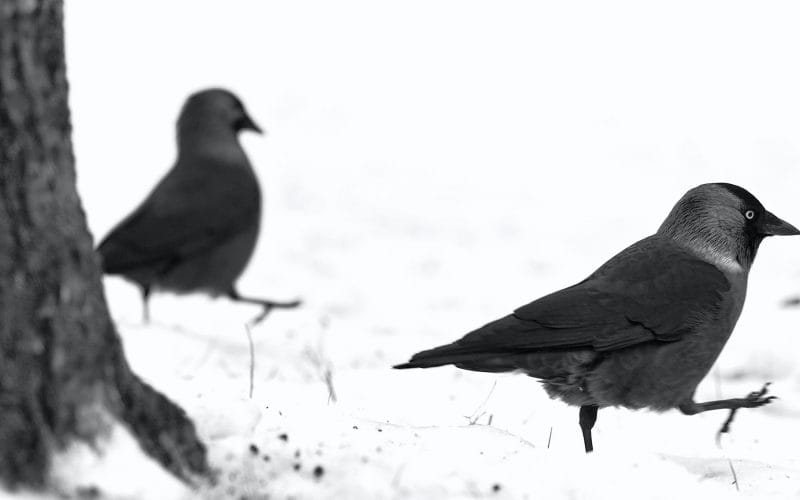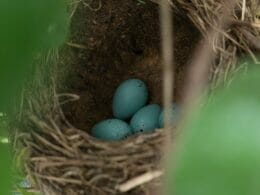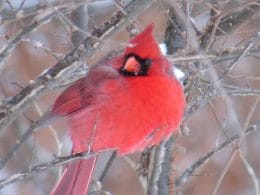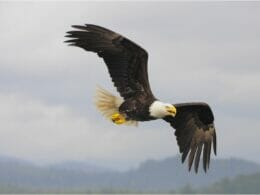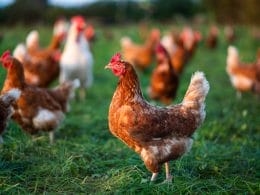Around springtime, woodpecker activity starts livening up. These delightful birds begin drumming out sweet nothings to one another and excavating their nests. Woodpeckers can peck up to 20 times per second, moving their heads around 15 miles an hour! So how do woodpeckers peck so fast?
It’s all in their anatomy: woodpecker neck muscles are extra developed to power the rapid pecking motion, while their beaks and skulls are designed to redistribute the impact through the rest of their body so that they don’t get head injuries.
It wasn’t until recently that researchers unraveled the mystery of how woodpeckers managed to peck up to 12000 times a day without injuring themselves. Their small skulls sometimes absorb 1400 times the force of gravity (1400g) with each peck.
Bearing in mind that a 60 to 100g impact would concuss a human, it’s quite a marvel that woodpeckers put themselves through over ten times worse than all day long!
Read on to find out how nature’s exquisite engineering makes it possible!
How Do Woodpeckers Peck So Fast
Woodpeckers’ strong neck muscles power up to 12000 pecks a day, at around 20 pecks a second. Aside from being well-developed for extra strength, the pecking muscles have evolved special biochemical pathways for faster movements.
Author Note: Woodpeckers’ strong tails and feet also give them the extra grip and balance needed to keep stable on the tree while pecking at high speed.
Speed is one thing, but the woodpecker also needs to deal with the impact of all those pecks. Being small and fast does help to reduce the amount of stress transmitted to the brain, but woodpeckers have a few ingenious adaptations to protect their brains and spread the force of impact around the rest of their bodies.
The Skull
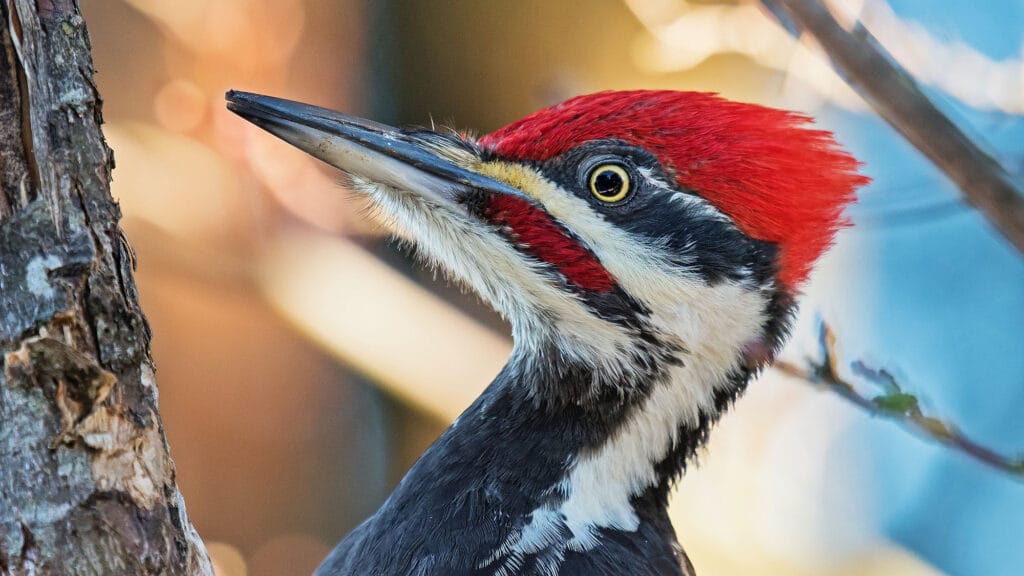
Woodpecker brains fit snugly in their skulls, which prevents them from sloshing around during rapid movement. The skull is also specially designed to scatter vibrations away from the point of impact. A dense outer layer protects a more porous inner layer, consisting of staggered plates of bone that work as a shock absorption system.
The Beak
Woodpeckers have sharp, dense beaks with a bit of an overbite. The upper beak juts out a little further than the lower beak, but the lower beak actually has a longer bone. The lower beak ends up absorbing most of the impact of pecking and redistributes it down through the body instead of through the upper beak into the head.
The scaly outer covering of the beak, common to all birds, follows a distinctive wavy pattern in woodpeckers which also helps dissipate some of the pecking force.
By the time the impact is transferred from the beak to the rest of the head, it is already 2 – 8 times weaker than at the tip of the beak. To stop the beak from wearing out over time, the cells at the tip are continually renewed.
The Hyoid Bone
The hyoid bone holds the tongue in place and allows it to move around. In most birds, it reaches the base of the skull, but in woodpeckers, it carries on wrapping around the back of the skull until it gets all the way back over to between the eyes, acting in a way like a safety belt for the brain!
Author Note: Each time the bird pecks, the tongue begins to extend forward, tightening the flexible hyoid around the cranial bones.
Behavioral Adaptations
Woodpeckers vary their angle very slightly with each peck, spreading the area of impact around a little. They also take frequent breaks to avoid their brains overheating!
Why Woodpeckers Peck

Throughout the year, woodpeckers will use their beaks to drill into decaying wood, searching for larvae and insects to eat. They also hollow out nests in trees in the springtime in the same way.
But what many people don’t realize is that woodpeckers also drum on trees with their beaks instead of singing to communicate with one another, which is when they peck fastest. Although woodpeckers can also produce short vocal sounds, drumming is used particularly in relation to mating and territoriality.
Sapsuckers and Flickers
Sapsuckers and flickers are members of the woodpecker family with specialized feeding habits. While sapsuckers drill holes to get at the plant nectar inside, flickers more often dig their prey out of the ground. Like other woodpeckers, sapsuckers and flickers nest in holes they excavate in trees and drum with their beaks to communicate with other members of their species. Flickers, in particular, are known for seeking out extra noisy surfaces like metal roofs to really get their message out there!
Where are Woodpeckers Found?
Picidae, the woodpecker family, is found across the globe except for Australasia, the poles, and a few islands. Different species of woodpecker are found throughout the USA, though the Southern states have a greater variety of species.
The vast majority of woodpecker species are found near forests, where there is an ample supply of wood to peck away at. A few species have adapted to drier climates and can be found in desert scrub where no forest is available. Some, like the Gila woodpecker, even make their nests in cacti!
What Woodpeckers Do I Get in My Yard?
There are over 20 species of woodpecker, sapsucker, and flicker in the USA. The species you’re most likely to encounter depending on what area you live in. One of the most widespread species is the Downy Woodpecker, the smallest woodpecker in the USA. The Hairy Woodpecker and the Northern Flicker, which dig for ants in the ground, also have broad ranges.
In the Northern States, the American Three-toed Woodpecker and the Black-Backed Woodpecker are quite common. America’s largest living woodpecker is the Pileated Woodpecker, native across large areas of the central states. This striking bird can excavate with such force that it has been known to break trees in half!
The Yellow-Bellied Sapsucker is America’s only migratory woodpecker, spending its winters in the South East and breeding in the North in Summer. Other woodpeckers often found in the South East are the Red-Bellied Woodpecker and the Red-Headed Woodpecker.
The West Coast has the highest diversity of woodpecker species. The Red-Naped Sapsucker, Red-breasted Sapsucker, and Acorn Woodpecker are among the most common there.
How to Attract Woodpeckers to Your Yard
Woodpeckers are a bit shyer than most common garden birds, but with a little effort, they can still be attracted to your backyard. Try placing their feeders, baths, and bird-houses near mature trees, where they are more comfortable and less likely to be bothered by other birds.
A garden with oak or pine trees has a better chance of attracting woodpeckers, and even more so if there are a variety of fruits and berries growing for food as well.
Woodpeckers will visit feeders and enjoy a variety of treats but be sure to feed consistently as they can take a while to become accustomed to the arrangement. Suet, peanuts, acorns, sunflower seeds, berries, sap, mealworms, and other insects are all good for attracting woodpeckers.
Remember that woodpeckers are specially designed to perch and feed upright, so an upright feeder with a tail stop (a flat piece that they can balance their tail against) is the most natural way for them to feed.
Woodpecker Facts
Woodpeckers belong to the family Picidae, which includes piculets and wrynecks as well. About 250 species in the family are distributed across the entire globe except for Madagascar, Australasia, and the poles.
Woodpecker tongues are exceptionally long for their size, reaching up to 4 inches in some species. They form part of the hyoid mechanism. In addition to moving the tongue in and out of the beak, it helps protect the brain from the impact of pecking. In some species, the tip of the tongue is barbed to help pull insects out of wood cavities!
Author Note: Woodpecker feet are zygodactyl, meaning that they have four toes, the outer two facing backward and the inner two facing forwards. This arrangement is what gives woodpeckers the strength to perch upright as they drill into tree trunks.
The tail feathers of woodpeckers are much stiffer than most birds, allowing them to brace themselves on their tails as they perch upright.
Woodpecker Anatomy

Woodpeckers’ faces are protected from flying bits of wood by nose feathers and nictitating membranes. The nose feathers stop debris going up the nostrils while the nictitating membrane, a third eyelid common to all birds, protects the delicate eye much like a pair of goggles.
The two largest woodpeckers, the American ivory-billed woodpecker and the imperial woodpecker from Mexico are extinct. The ivory-billed woodpecker, with a wingspan of around 2.5 ft, was last seen in the USA in 1944. The largest species still known in the USA is now the pileated woodpecker, which is quite similar looking and just slightly smaller.
Woodpeckers are so good at hammering without damaging their heads that their anatomy has been studied to improve protective headgear, shock absorption systems, and hammers. Woodpecker brains are also studied to better understand the effects of mechanical stress on brain tissues.
Different species of woodpeckers excavate holes of different sizes and shapes. The pileated woodpecker, for example, makes rectangular holes!
Woodpeckers in Culture and Mythology
Perhaps the most famous woodpecker in modern culture is the fictional cartoon character Woody Woodpecker. Woody’s species is debatable, though, with experts pointing out that he has features of both the red-headed and the pileated woodpecker.
In Native American culture, the woodpecker is one of the zodiac signs, and woodpecker drumming is considered symbolic of mother nature’s heartbeat. In Norse mythology, woodpeckers are associated with Thor, the god of thunder, with whom they are likened because of their drumming. The Romans worshipped a woodpecker god named Picus, who was associated with fertile soils.
Conclusion
The woodpecker is seen as a positive omen in many cultures, and it certainly feels like it when you come across one in your yard! Next time you hear one tapping away at a tree, take a look to see if it’s drilling in for some snacks, getting a nest ready, or just having a chat with some bird nearby! We hope you enjoyed this article on how do woodpeckers peck so fast.
Fly high friends!
FAQ
It does so in 2 ways. Firstly, it is strong enough to absorb a lot of the impact from pecking. Then it diverts the energy away from the brain.
Strangely enough, it is the Powerful Woodpecker (Campephilus pollens), which is found in South America.
Yes it is, despite all that headbanging! They are adaptable, sociable and most importantly, play a vital role in the ecosystems of their environments.




